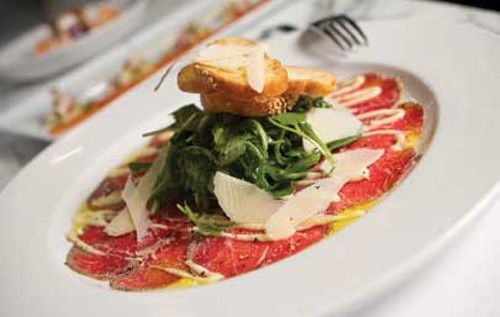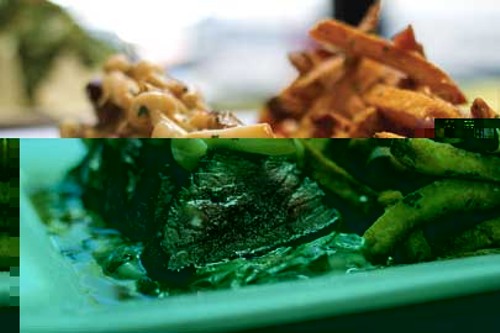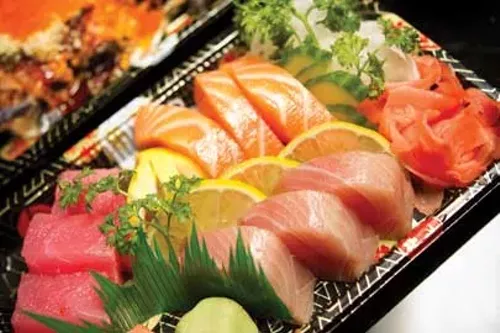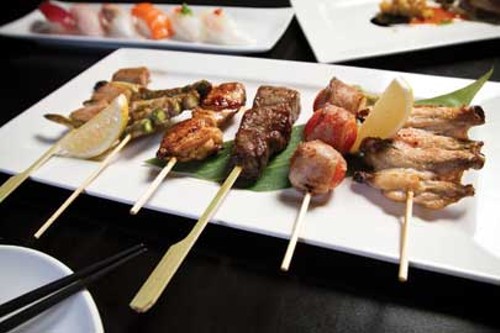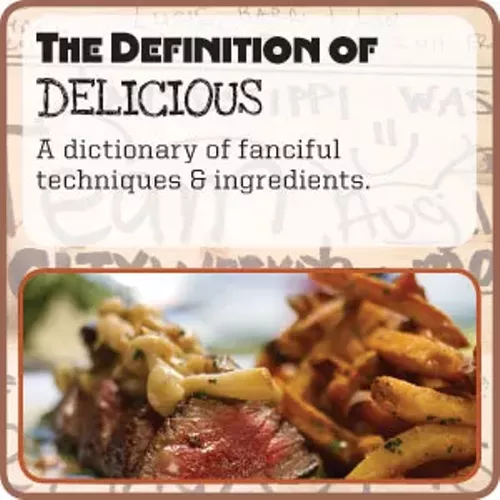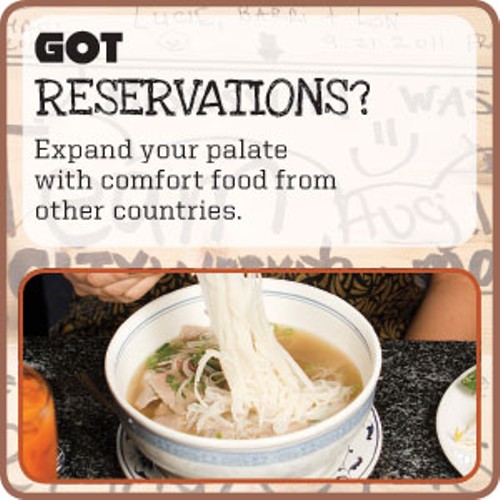The Definition of Delicious
An A-to-Z local-dining dictionary of fanciful techniques and ingredients
By Ted Scheffler @critic1Cookbooks, food writing and restaurant menus are filled with culinary terms that may or may not be familiar to the reader. Many come from the French, since many cooking techniques and methods can be traced back to France. How often have you come across the term verjus on a menu and wondered if it’s something you’ll love or something you should skip? This brief culinary dictionary should help.
Al dente: In Italian, it means “to the tooth” and refers usually to pasta—but also to rice and sometimes veggies—cooked to a firm state, but not crunchy, so that there’s a little resistance when bitten into. The pasta at Fresco Italian Cafe (1513 S. 500 East, Salt Lake City, 801-486-1300, FrescoItalianCafe.com) is always perfectly cooked.
Brine: A method of tenderizing meat, seafood, poultry and such via a saltwater (and sometimes sugar) soak to help foods retain moisture. I highly recommend overnight brining for holiday turkeys. At Papa O’s in Draper (11483 S. State, 801-619-3503), they brine the chicken pieces before frying them.
Carpaccio: Usually refers to super thin (almost see-through) slices of raw beef, typically served with olive oil, salt and pepper, but can also mean thin slices of anything—seafood, veggies, etc. The beef carpaccio at Vivace (308 W. Broadway, Salt Lake City, 801-328-3466, DineVivace.com) is excellent.
Duxelle: Minced mushrooms and shallots cooked in butter and wine (sometimes Madeira), typically used as a stuffing or filling for things like omelets. The Pleasant Creek Ranch beef at Pago (878 S. 900 East, Salt Lake City, 801-532-0777, PagoSLC.com) comes with delicious duxelles.
En Papillote/En Croute: En papillote is a French cooking method where food is cooked in a paper bag; en croute is food baked in pastry crust or bread. Tin Angel Cafe (365 W. 400 South, Salt Lake City, 801-328-4155, TheTinAngel.com) does a tasty cheese en croute with fresh Asiago.
Fond: This is the yummy bits of concentrated food that stay in the pan after sauteing meats and poultry. Cooks typically deglaze the pan to scrape up the fond that flavors gravy and sauces. It’s fond that helps makes the braciola at Ghidotti’s (6030 Market St., Park City, 435-658-0669, BillWhiteRestaurantGroup.com) so damned delicious.
Ghee: Clarified butter used for cooking in South Asia, particularly Indian, Pakistani, Bangladeshi, Nepali and Iranian cuisines. You can find ghee at Whole Foods, Eastern Groceries and House of Spices, to name a few.
Head cheese: A meat terrine or jelly made from parts of a pig or calf head, also called brawn. Visit Caputo’s (314 W. Broadway, Salt Lake City, 801-531-8669; 1516 S. 1500 East, Salt Lake City, 801-486-6615, CaputosDeli.com) butcher, Frody Volgger, or Siegfried’s Deli (20 W. 200 South, Salt Lake City, 801-355-3891, SiegfriedsDelicatessen.biz) to get some.
Injera: A spongy, yeast-risen flatbread that is ubiquitous in Ethiopian and Eritrean cuisines and used much like tortillas are in Mexico. You’ll find it at Salt Lake City restaurants like Blue Nile (755 S. State, 801-364-4042, BlueNileSLC.com), Mahider (1465 S. State, 801-975-1111) and Red Sea Café (815 E. 2100 South, 801-486-1140).
Julienne: The method of cutting food into matchstick-size strips, supposedly named for French chef Jean Julien. The fried tortilla “straws” atop Log Haven’s (6451 E. Millcreek Canyon Road, Salt Lake City, 801-272-8255, Log-Haven.com) roasted Anaheim-chile soup with braised pork cheek are julienned.
Kobe: Referred, originally, to beef that came from Japan’s Tajima-sushi breed of Wagyu cattle—renowned for its tenderness and flavor. Snowbird’s Steak Pit restaurant (9600 Little Cottonwood Canyon Road, Snowbird, 801-933-2260, Snowbird.com) features American Kobe beef.
Lagniappe: A Creole word that means, in a culinary context, “something added” or “a little something extra,” such as a complimentary dessert, a free drink, etc. An example of this are the bite-size hors d’oeuvres called amuse bouche that are served at Talisker on Main (515 Main, Park City, 435-658-5479, TaliskerOnMain.com).
Mis-en-place: French for “everything in place.” One of the most important and elemental concepts in cooking—to have tools, ingredients, etc., lined up and orderly before cooking. Every restaurant worth its salt has a well-ordered mis-en-place.
Nouvelle Cuisine: A French cooking movement—“new cuisine”—that took hold in the 1960s and was made popular by chefs like Roger Verge, Paul Bocuse, Alain Chapel and Pierre Troisgros. Nouvelle cuisine was a mainstay of Salt Lake City’s now-shuttered Metropolitan.
Offal: Refers to organ meats used in cooking, such as sweetbreads, foie gras, chopped liver and such. The Paris Bistro (1500 S. 1500 East, Salt Lake City, 801-486-5585, TheParis.net) features sweetbreads à la Grenobloise (meaning they’re served with a sauce of browned butter, capers, parsley and pieces of lemon) on its menu, and there’s Le Belle Farm foie gras at Silver (508 Main, Park City, 435-940-1000, SilverRestaurant.com).
Paillard: Sometimes also called scallop, escalope or scallopine, paillard refers to thinly sliced, boneless, pounded pieces of meat, poultry or fish—especially veal and chicken. The popular chicken piccata at Cucina Toscana (307 W. Pierpont Ave., Salt Lake City, 801-328-3463, Cucina-Toscana.com) is paillard-style.
Quatre epices: A blend of spices commonly used in French cooking and also in Middle Eastern cuisines, usually combining ground pepper, nutmeg, cloves and ginger. Find it at Liberty Heights Fresh (1290 S. 1100 East, Salt Lake City, 801-467-2434, LibertyHeightsFresh.com).
Robata: A type of high-heat charcoal grill used in Japanese cooking for preparing yakitori (see p. 40). In Japan, robata means “by the fireside.” The guys at Forage (370 E. 900 South, Salt Lake City, 801-708-7834, ForageRestaurant.com) do some of their grilling using a robata.
Sushi/Sashimi: Contrary to common belief, sushi does not mean raw fish. It refers to food—fish, veggies, meats, etc.—prepared using vinegared rice (sushi rice), such as maki rolls, nigiri, inari and temaki. Sashimi is sliced raw fish and seafood served without rice. Find both during the never-ending sushi happy hour at Red Ginger Bistro (3333 S. State, Salt Lake City, 801-467-6697, RedGingerBistroSLC.com).
Trattoria: An Italian-style eatery that is less formal than a ristorante, usually without printed menus and serving modest, but inexpensive Italian fare. See, for example, Zucca Trattoria (1479 E. 5600 South, South Ogden, 801-475-7077, MyZucca.com).
Umami: Commonly called the “fifth taste,” along with bitter, salty, sweet and sour. It’s present in certain rich foods such as mushrooms, cured meats, soy sauce, sea urchin and Japanese dashi. The ankimo (monkfish liver) at Takashi (18 Market St., Salt Lake City, 801-519-9595) has classic umami taste.
Verjus/Verjuice: An acidic juice made from unripe pressed grapes or other sour fruits, mostly used in salad dressings and sauces. Verjus vinaigrette adorns the chopped salad at Cafe Trio (680 S. 900 East, Salt Lake City, 801-533-8746; 6405 S. 2000 East, Salt Lake City, 801-944-8746, TrioDining.com).
Wasabi: Also called Japanese horseradish, wasabi is a root plant used as a condiment in Japanese cuisine. It’s best when freshly shredded, but more commonly seen as a ready-to-use paste or in reconstituted dried-powder form. It almost always accompanies sushi. Just visit your favorite sushi restaurant: Dojo (423 W. 300 South, Salt Lake City, 801-328-3333, DojoSLC.com), Shogun (321 S. Main, Salt Lake City, 801-364-7142, ShogunSLC.com) ... you name it.
Yakitori: Refers in Japanese specifically to skewered and grilled chicken (usually on a robata grill), but has come to be used in reference to any skewered and grilled foods. Visit Naked Fish (67 W. 100 South, Salt Lake City, 801-595-8888, NakedFishBistro.com) for a tasty yakitori experience.
Xia: On Chinese restaurant menus, this means shrimp—like the heavenly salt-baked shrimp at Little World (1356 S. State, Salt Lake City, 801-467-5213, UtahChinese.org).
Zabaglione: Also called zabaione, sabayon and zabajone, this means “egg punch” in Italian—a light, custard-like dessert made using egg yolks, sugar, a little salt and sweet wine, usually Marsala or Moscato d’Asti. Park City’s Grappa restaurant (151 Main, Park City, 435-645-0636, BillWhiteRestaurantGroup.com) serves up yummy zabaglione.
|
|
|
|
|
|
|
|
|
|
|
|
More by Ted Scheffler
-
Flavor on the Western Front
Nomad Eatery ups the ante for off-airport eats.
- Dec 13, 2017
-
Under the Christmas Tree
Holiday gifts for cooks, foodies and winos
- Dec 6, 2017
-
Spreading the Love
Amour Café creates simple yet scrumptious fare.
- Nov 29, 2017
- More »



